Basketball Rebounding Tips, Techniques and Fundamentals
By Dr. James Gels, From the Coach’s Clipboard Basketball Playbook"Helping coaches coach better..."
Rebounding is one of the most important aspects of winning games. Offensive rebounding gives your team extra chances, and free throw opportunities, and frustrates the defense. Defensive rebounding is a key part of good defense, limiting the offense to one shot. A good thought is "one shot and out".
Defensive rebounding combined with a quick outlet pass can be an effective offensive weapon, getting the transition game and fast break going. All good rebounders "have an attitude", a mind-set, that every rebound is theirs and are very aggressive on the boards. You’ve got to want it!
Coaches love good rebounders and will reward them with more playing time. You may not be the best shooter or ball handler, but if you are a strong rebounder and defender, you will get to play. Good rebounders are important "role players".
Disclosure: This page contains affiliate links, which means that Coach's Clipboard receives a small commission (at no cost to you) if you make a purchase using these links.
Developing a Rebounding Mind-Set
Players must begin to develop a rebounding "mind-set" at an early age. Just like learning ball-handling, dribbling, shooting and other skills, they have to be taught the importance of rebounding and rebounding techniques early in their development."Desire outweighs footwork when it comes to crashing the glass." - Bill Self
"A player's ability to rebound is inversely proportional to the distance between where he was born and the nearest railroad tracks. The greater distance you live from the poor side of the railroad tracks, the less likely that you will be a good rebounder." - Pete Carril
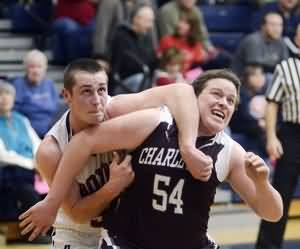
This mind-set is something that needs to be ingrained early in a player's development. Get with your youth, middle school, freshman and JV coaches and make this a priority, so that when they are at the varsity level, they already have that mind-set.
To help develop this attitude, as coach you must every day stress that rebounding is a very high priority for you. In addition to rebounding drills, have the mind-set that every drill is a rebounding drill. Once the shot goes up in any drill (be it offensive, defensive, shooting, etc) players must box-out and rebound - and "finish the drill!"
When players don't box-out, rebound and don't finish drills, have them run. You'll hate to do it, but you may have to bench your star shooter for a minute or two if he/she is not boxing-out and rebounding.
You have to send them the message. The best situation is when your players buy into it, are mentally tough, and take pride and ownership of their rebounding, and demand it of each other.
Chris Mack: Smorgasbord of Basketball Practice Drills:
Defensive Rebounding
The first important aspect of rebounding is getting inside position and "boxing out". The player who gets the inside position usually gets the rebound. The opponent may "reach over" and commit a foul. These "over the back" fouls can be very costly late in a game when teams are in the bonus free throw situation.Another key is always knowing where the ball is, so as soon as you see the shot being taken you get the inside position and box out. It helps if teammates communicate and yell "shot!" when the shot goes up.
There are three parts to a defensive rebound - (1) the box-out, (2) attacking the ball, and (3) the outlet pass."Box Out"
All players must learn this skill. Even perimeter players (guards) must be rebounders. Oftentimes, the missed 3-point shot results in a long rebound that our guards can get if they box-out properly. We don’t want the opponent’s guards slipping inside for the rebound and put-back.Boxing out near the basket, or "war zone". When you box out, you must first make contact with the player you are guarding. Locate your man, get in front of him/her, pivot facing the basket, bend over, get wide with your feet and arms out, and put your backside into the offensive player, sealing him/her away from the hoop.
Be aggressive, and don't let the offensive player push you under the basket. If you get too far under the basket, a taller opponent with long arms can simply outreach you for the ball. Keep your man away from the hoop. Keep your eye on the flight of the ball, and go get it!
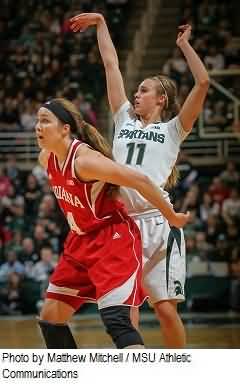
Boxing-out the shooter
If he tries to get around you, "arc" him outside, and then aggressively pursue the ball. If your man is stronger and pushes or forces you inside the war zone, then use the standard block-out technique used in the war zone. If your man releases away from the basket to half-court as a "safety", go to the closest elbow and rebound from there. Often the 3-point shot results in a long rebound to either elbow.
Attack The Ball
After you have sealed (boxed-out) the opponent, go aggressively after the ball. Attack the ball, jumping high with both arms extended, grab it strongly with both hands, and "rip it down".Expect some physical contact. You’ve got to be strong and tough inside. Once you have the ball, protect it by pivoting away from the opponents, and "chin" it, by bringing the ball under your chin with elbows out. But you must not throw an elbow - a sure foul, often flagrant.
The Outlet Pass
Once you have the ball, think "fast break". Get a quick accurate outlet pass to a teammate to get the transition game going. If you hold onto the ball too long, the opponents may tie you up, and depending on the possession arrow, all your hard work is for nothing.So immediately pivot away from the defenders toward the sideline and find a teammate to pass to. Pivot on your outside (or baseline) foot. Wheel around and make a strong, sharp two-handed overhead outlet pass to your teammate on the wing. Only dribble if you have to, if you are in trouble and need to create spacing to get the pass off.
Pass as soon as you can safely hit your teammate. Don't make a bad forced pass, and lose possession. I hate it when one of my players makes a good box-out, gets the rebound, but then simply throws the ball away with a bad pass - all the good, hard work ruined by a bad pass. Those kind of turnovers can kill you, as the opponent may get a quick shot or lay-up after the steal.
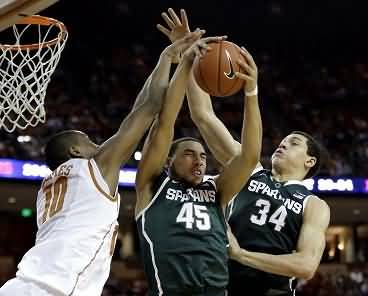
Team Rebounding Concepts
The rebounding triangle
With each shot, try to establish a triangle of players boxing out around the basket. Have one player on each side of the basket and one in front, creating a rebounding triangle. Don't get too far under the basket, where a taller player can reach over your head for the rebound - box them away from the basket.
Weakside rebounding
Another tip - realize that about 70% of missed shots from the corner or wing go long to the opposite side of the hoop. So make sure you have a weakside rebounder when the corner-wing shot goes up.
Long rebounds
Long rebounds often occur after a missed 3-point shot. Try to have two perimeter defenders (rebounders) get to the wing-elbow areas on each side to help secure those long rebounds that go over the guys boxing out inside.
Rebounding missed free-throws
Not boxing out the offensive rebounders along the free-throw lane loses games. See "Boxing Out on a Free-Throw" below.
Offensive Rebounding
Offensive rebounding should be an important part of your team offense. Nothing frustrates the opponent more, than their playing good aggressive defense, and you get one, two, or three offensive rebounds for more shots, until you finally score.The keys are you've got to be aggressive and want the offensive rebound, and you must be quick on your feet and get inside position. This is a good way to pick up extra easy baskets. Some people call these "garbage" baskets. I call them hard-working, smart, demoralizing baskets - "back breakers".
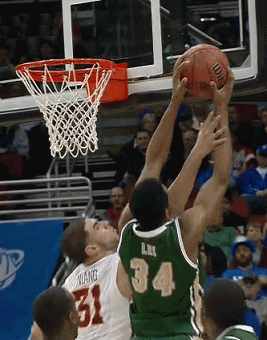
Getting Position:
The defender should already be between you and the hoop and trying to box you out. Make a fake one way, and quickly move your feet and slip around him/her on the other side. Once you are inside, now you box out.
Offensive rebounders should learn the spin move and the swim move. If your back is to the basket when the shot goes up, stay low and spin around the offensive player. If you are facing the defender when the shot goes up, "swim" over him/her to get inside position. If the defender does not have his/her arms up, put your forearm on top of his/hers, pinning it down (without grabbing or holding it), and then move your feet and step around and over the opponent's foot and get inside rebounding position.
Always know where the ball is and assume that every shot will be missed. If the shot is coming from the corner, remember that 70% of misses will go long on the opposite side, so be ready on the weakside.
Once you get the ball, be strong and power it right back up to the hoop, usually off the glass. There is a good chance you will get fouled, and have a good chance for an "old fashioned" 3-pointer - a put back with a free throw. Expect contact, be strong, and finish the shot.
If you are in traffic and don't have a good shot, pass back outside to an open perimeter player. Don't force a bad shot.
If you are not in a position to grab and secure the rebound, you might be able to get one hand on it and tip it away from the opponent to a teammate.
Work hard the entire game and make your opponent work. You can wear the opponent down. When your team is behind, the two key elements in catching up and winning are playing great defense and rebounding. If you can stop the opponent from scoring, you give your offense a chance to catch up.
Many championship games are decided by this tough inside play - not the outside jumpers. It's not always pretty under the hoop, but coaches know how important this aspect of the game is. You will hear TV commentators talk about "points in the paint" as a key in many games. Most of them are retired, successful coaches, and they know by experience how important.
Boxing Out on a Free-Throw
Rebounding missed free-throws is often under-taught and failing to do so can cost you a close game.Defensive Rebounding a Free-Throw
It's very important to secure the defensive rebound after a missed free-throw. When you are behind late in the game and you have to foul to stop the clock and to gain possession, you can't let the opponent get the rebound and maintain possession.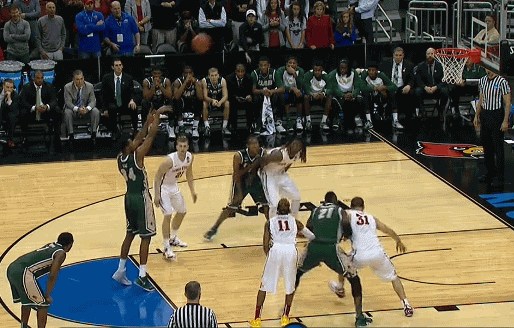
The defensive rebounders in the lowest space along the lane must block-out the adjacent opponent in the middle space. The defender should get close to the offensive player. For example, if you are on the right side of the lane, have your top (left) foot as near as possible to the offensive player.
Then when the ball hits the rim, immediately slide that foot over into the lane in front of the opponent. The stance should not be too wide, but wide enough for a strong base, so that the opponent cannot push you under the basket. If you are too wide, it will be more difficult to slide that leg over.
Turn your body with the bottom (right) foot back off the lane line a little (never have both feet touching or parallel to the lane line). Most of your weight should be on the bottom (right) foot. Keep your arms up with your elbows shoulder height.
Not only does this get you ready to rebound, but if you let your arms down, a savvy offensive player may put his arm on top of yours, pinning it down (and this is often not caught by the officials). Use your hands and arms also to feel which way the offensive player is going and block him/her out.
The rebounders in the top two lane positions should position themselves in their space along the lane as close to the basket (and the middle offensive player) as possible. They must communicate. One, positioned next to the opponent's best rebounder, steps aggressively into the middle of the lane and "pinches" the offensive rebounder, by stepping into him from the top. The other should make contact with and box-out the shooter.
Offensive Rebounding a Free-Throw
To get the offensive rebound after a missed free-throw, the two rebounders on the lane can attempt to get inside by using either a spin move to the baseline, or a swim move (see above) to the lane. If you sense that the inside defender is blocking you in the lane, spin to the baseline. If he is blocking you low, swim over him into the lane.Another trick is for either of the rebounders to tip, or slap, the ball outside to one of their guards.
Rebounding Out of a Zone Defense
Defensive rebounding out of a man-to-man defense is fairly straight forward, usually with clear-cut box-out assignments. But what about defensive rebounding out of a zone defense? See Zone Defense Rebounding.Related pages: